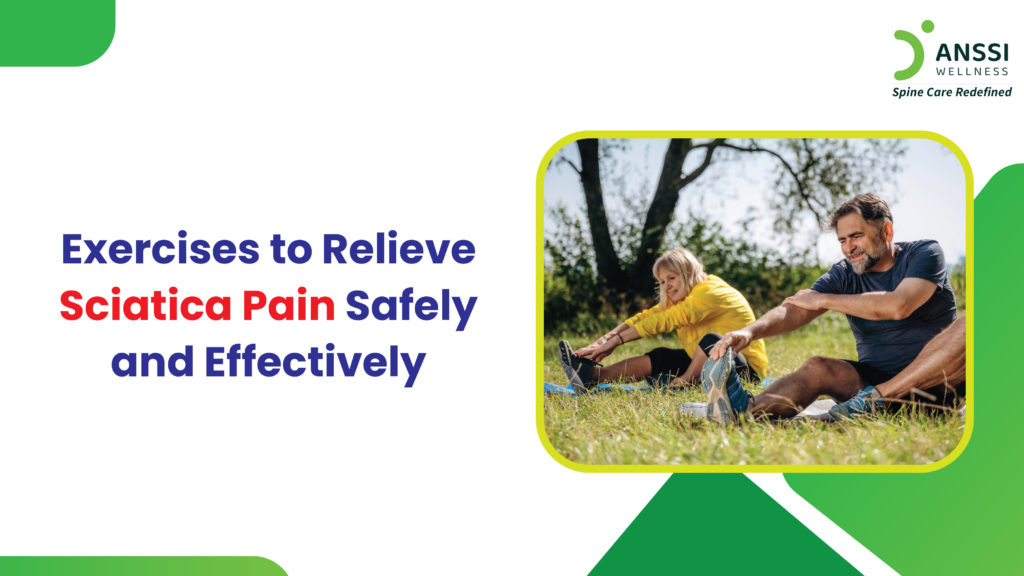Sciatica pain can be crippling, impairing your everyday activities and general well-being. It happens when there is compression or irritation of the sciatic nerve, which travels from the lower back down the legs. Managing sciatica effectively requires you to combine targeted exercises with advanced non-surgical treatments like spinal decompression.
Let’s identify safe and effective exercises to relieve sciatica pain and discuss how combining them with other treatment methods can provide you with long-term relief.
Understanding Sciatica and Its Symptoms
Compression or inflammation of the sciatic nerve results in sciatica. Herniated discs, spinal stenosis, and lower back muscle stress are common causes.
Symptoms of sciatica include:
- Severe pain that travels down the legs from the lower back
- Legs or feet that are numb or tingly
- Weakness in the affected leg
- Difficulty standing or walking for long periods
Sciatica-Friendly Exercises for Pain Relief
Regular exercise plays a crucial role in relieving sciatica pain by improving flexibility, strengthening muscles, and reducing nerve compression.
Knee-to-Chest Stretch
- Lying on your back, bend both knees.
- Bring one knee slowly up to your chest.
- Hold it there for 20 to 30 seconds.
- Repeat with the other leg.
Benefit: It helps release pressure from the lower back and sciatic nerve.
Seated Spinal Twist
- Sit with both legs extended in front.
- Bend the right knee and place your right foot over the left leg.
- Twist your torso to the right while placing your right hand behind you for support.
- Hold for 20 seconds and switch sides.
Benefit: It increases spinal flexibility and reduces nerve compression.
Piriformis Stretch
- Lying on your back, bend both knees.
- Place your right ankle over the left knee.
- Hold the back of the left thigh and pull it toward your chest.
- After 30 seconds of holding, repeat with the opposite leg.
Benefit: It loosens the piriformis muscle, which can aggravate sciatica pain.
Cat-Cow Stretch
- Take a tabletop position by getting down on your hands and knees.
- Inhale and arch your back (cow pose), looking up.
- Round your back into cat posture, exhale, and tuck your chin in.
- Repeat for 1-2 minutes.
Benefit: It improves spinal mobility and reduces stiffness.
Child’s Pose
- Kneel on the ground while sitting on your heels.
- Move your chest down while stretching the arms in front.
- Hold for 30 seconds.
Benefit: It stretches the lower back and relieves pressure on the sciatic nerve.
Standing Hamstring Stretch
- Place one leg on an elevated surface while keeping it straight.
- Keep your back straight and bend a little forward.
- Hold for 20 seconds and switch sides.
Benefit: It reduces tension in the hamstrings, which can contribute to sciatic pain.
Pelvic Tilts
- Lie on your back.
- Keep the feet flat on the ground while bending the knees.
- Press your lower back down by tensing your abdominal muscles.
- Hold for 5 seconds and release. Repeat 10 times.
Benefit: It strengthens core muscles and supports spinal stability.
Combining Exercise with Non-Surgical Spinal Decompression
While exercises help reduce sciatica pain, they may not be enough for severe cases. Non-surgical spinal decompression treatment is an effective treatment for sciatica, especially when combined with regular stretching and strengthening exercises.
How Spinal Decompression Works
- Uses a specialised machine to gently stretch the spine.
- Causes the discs to experience negative pressure, which permits herniated or bulging discs to retract.
- Improves nutrient and oxygen flow to the affected area, promoting natural healing.
Why Choose Spinal Decompression?
- Pain-free and non-invasive
- Provides long-term relief without medication
- Reduces pressure on the sciatic nerve
When combined with targeted exercises, spinal decompression enhances mobility and prevents future flare-ups.
Additional Tips for Managing Sciatica
There are certain lifestyle changes that you can adopt to reduce the discomfort.
- Maintain Good Posture: Do not slouch when standing or sitting.
- Stay Active: Engage in low-impact activities like swimming and walking.
- Use Ergonomic Support: Choose a supportive chair and mattress.
- Apply Heat or Ice Therapy: Use ice packs or warm compresses to reduce pain and inflammation.
- Maintain a Healthy Weight: Manage weight to reduce strain on the lower back.
However, if you experience persistent sciatic pain, consult a specialist to explore the best treatment options for you.
About ANSSI:
ANSSI Wellness focuses on improving the quality of life for patients suffering from spinal issues, aiming to provide relief where other conventional treatments have failed. Through advanced non-surgical spinal decompression treatment, ANSSI is committed to helping patients avoid surgery and recover in a safe, effective, and compassionate environment.
Connect with ANSSI Wellness on LinkedIn, Instagram, and Facebook for expert guidance.



